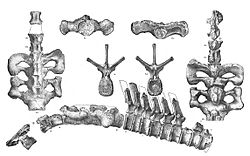Agathaumas
|
Agathaumas Temporal range: Late Cretaceous, 66 Ma |
|
|---|---|
 |
|
| Illustration of the vertebrae and sacrum | |
| Scientific classification | |
| Kingdom: | Animalia |
| Phylum: | Chordata |
| Class: | Reptilia |
| Clade: | Dinosauria |
| Order: | †Ornithischia |
| Family: | †Ceratopsidae |
| Subfamily: | †Chasmosaurinae |
| Tribe: | †Triceratopsini |
| Genus: |
†Agathaumas Cope, 1872 |
| Species: | †A. sylvestris |
| Binomial name | |
|
Agathaumas sylvestris Cope, 1872 |
|
Agathaumas (/æɡəˈθɔːməs/; "great wonder") is a dubious genus of a large ceratopsid dinosaur that lived in Wyoming during the Late Cretaceous (late Maastrichtian stage, 66 million years ago). The name comes from Greek, αγαν - 'much' and θαυμα - 'wonder'. It is estimated to have been 9 metres (30 ft) long and weighed 6 tonnes (5.9 long tons; 6.6 short tons), and was seen as the largest land animal known at the time of its discovery.
It was the first named ceratopsian, though relatively little is known about it. The original specimen consisted only of the animal's hip bones, hip vertebrae and ribs, and because these bones vary little between ceratopsid species, it is usually considered a nomen dubium. It is provisionally considered a synonym of Triceratops, but is difficult to compare to that genus because it is only known from postcranial remains.
The fossil remains of Agathaumas were first found in 1872 in southwestern Wyoming. They were discovered by Fielding Bradford Meek and Henry Martyn Bannister while they were looking for fossil shells in the Lance Formation (then Laramie Formation) near the Black Butte and Bitter Creek. Meek and Bannister were employed by Ferdinand Vandeveer Hayden's Geological Survey of the Territories, and notified paleontologist Edward Drinker Cope of the find. Cope himself searched the ridge near Black Butte and re-discovered Meek's site, finding huge bones protruding from the rocks near a coal vein. The bones were preserved in sand and clay sediments, packed with fossil sticks and leaves, indicating a heavily forested habitat. Cope later (in 1873) described the skeleton as "the wreck of one of the princes among giants." Later in 1872, Cope published a description and name for the animal, Agathaumas sylvestris, or "marvelous forest-dweller," in reference to its great size and the environment revealed in the same rocks as its bones. The name Agathaumas has been cited as an example of Cope's excitement with this discovery, which he considered, at the time, as the largest known land animal that had ever lived. Several years later, with the discovery of the giant sauropod dinosaurs of the Morrison Formation, it became clear to him that British forms as Cetiosaurus and Pelorosaurus were land animals.
...
Wikipedia
